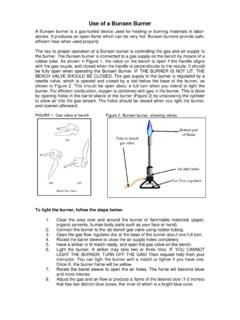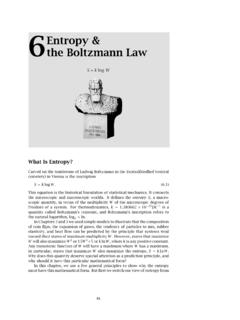Transcription of 14-5 The Maxwell-Boltzmann Distribution; …
1 Answer to Essential Question : All we need to do is to increase the temperature of the piston. Based on our analysis in Exploration , raising the absolute temperature by 20% moves the piston from the state labeled Piston 1 to that labeled Piston The Maxwell-Boltzmann distribution ; EquipartitionWe come now to James Clerk maxwell , the Scottish physicist who determined that the probability a molecule in a container of ideal gas has a particular speed v is given by:, (Equation : Maxwell-Boltzmann distribution )where M is the molar mass (mass of 1 mole) of the distribution of speeds is known as the Maxwell-Boltzmann distribution , and it is characterized by three speeds. These are, in decreasing order:; (Equation : the rms speed); (Equation : the average speed).
2 (Equation : the most probable speed)Plots of the Maxwell-Boltzmann distribution are shown in Figure for two different temperatures and two different monatomic gases, argon and helium. Table shows the speeds characterizing the distributions. At low temperatures the molecules do not have much energy, on average, so the distribution clusters around the most probable speed. As temperature increases the distribution stretches out toward higher speeds. The area under the curve stays the same (it is the probability an atom has some velocity, which is 1) so the probability at the peak decreases. Chapter 14 Thermal Physics: A Microscopic View Page 14 - 10 Figure : Maxwell-Boltzmann distributions at two different temperatures, 120 K and 300 K, for monatomic argon gas (the darker and taller curves, for argon with a molar mass of 40 g) and monatomic helium gas (lighter and shorter curves, with a molar mass of 4 g).
3 Table : The various speeds characterizing the Maxwell-Boltzmann distribution of speeds for monatomic argon gas, and for monatomic helium gas, at temperatures of 120 K and 300 K. The Equipartition TheoremEarlier, we applied basic principles of mechanics to find that . If we multiply by a factor of N, the number of atoms in the ideal gas, the equation becomes:. (Eq. : Internal energy of a monatomic ideal gas)Equation gives the total energy associated with the motion of the atoms in the ideal gas. This is known as the internal energy. The equipartition theorem states that all contributions to the internal energy contribute equally. For a monatomic ideal gas there are three contributions, coming from motion in the x, y, and z directions.
4 Each direction thus contributes to the internal energy. Each motion contributing to internal energy is called a degree of freedom. Thus:. (Eq. )Consider a diatomic ideal gas, in which each molecule consists of two atoms. At low temperatures, only translational kinetic energy is important, but at intermediate temperatures (the range we will generally be interested in) rotation becomes important. As shown in Figure , rotational kinetic energy is important for rotation about two axes but can be neglected for the third axis because the rotational inertia is negligible for rotation about that axis. With five degrees of freedom, each counting for , the internal energy of a diatomic ideal gas is:. (Eq. : Internal energy of a diatomic ideal gas)At high temperatures, energy associated with the vibration of the atoms becomes important and there are two additional degrees of freedom (one associated with kinetic energy, one with elastic potential energy) to bring the coefficient in front of the NkT to 7 molecules, at intermediate temperatures, have six degrees of freedom, translational kinetic energy in three dimensions, and rotational kinetic energy about three (Eq.)
5 : Internal energy of a polyatomic ideal gas)Related End-of-Chapter Exercises: 38, 47, 48, Question : Two containers have identical volumes, temperatures, and the same number of moles of gas. One contains monatomic ideal gas while the other has diatomic ideal gas. Which container has a higher pressure? In which does the gas have more internal energy?Chapter 14 Thermal Physics: A Microscopic View Page 14 - 11(m/s)(m/s)(m/s)Argon, T = 120 K273252223 Argon, T = 300 K432398353 Helium, T = 120 K865797706 Helium, T = 300 K136712601116 Figure : A diatomic molecule is modeled as two balls connected by a light rod. In addition to translating in three dimensions the molecule can rotate about axes 1 or 2, for a total of five degrees of freedom.
6 There is no contribution to the internal energy from rotation about axis 3 because the molecule has negligible rotational inertia about that axis.















![XiTkjNlm`k]gR TknWopR crq lms tHu R vwTkXiq](/cache/preview/0/6/0/4/3/b/0/9/thumb-06043b09a92afe85fe6fb5ea35baaecc.jpg)